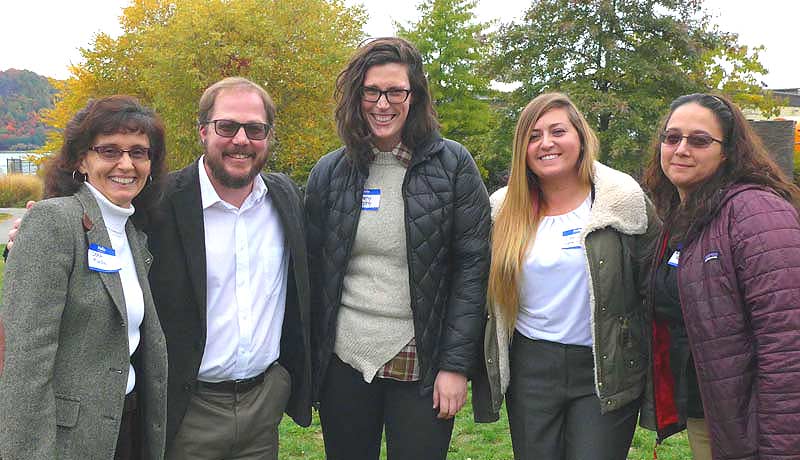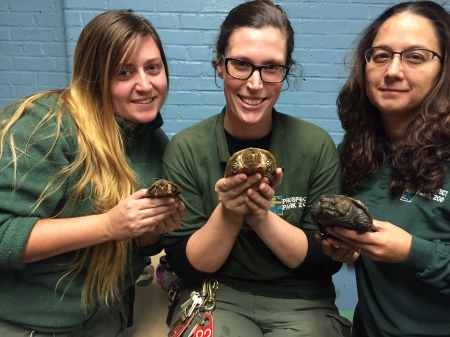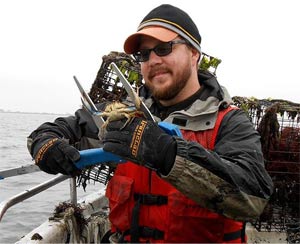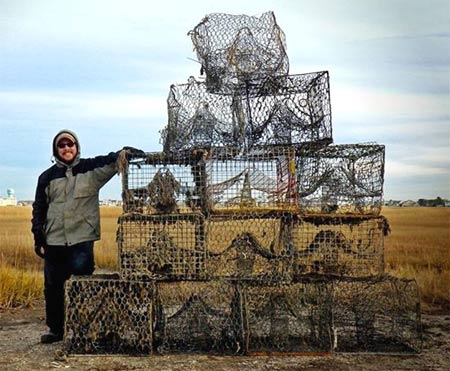 

The New York Turtle and Tortoise Society presents

Seminar 2015

Saturday, October 24, 2015
Check-in 9:30 a.m.; Sessions 10:00 a.m.–5:00 p.m.

Sarah Lawrence College Center for the Urban River at Beczak
35 Alexander Street, Yonkers, New York 10701
 Speakers at Seminar 2015 — Theodora Pinou, Ben Atkinson, Britney Murphy, Danielle Taylor-Lang, and Nichole Shelmidine
Speakers at Seminar 2015 — Theodora Pinou, Ben Atkinson, Britney Murphy, Danielle Taylor-Lang, and Nichole Shelmidine

Photo by Anita Salzberg |

 Program
Program

Nichole Shelmidine,1 Brittany Murphy,2 and Danielle Taylor-Lang3
 1
1Animal Supervisor, WCS/Prospect Park Zoo
2Senior Wild Animal Keeper, WCS/Prospect Park Zoo
3Wild Animal Keeper, WCS/Prospect Park Zoo
 “Husbandry and Propagation of the Chinese Big-Headed Turtle
“Husbandry and Propagation of the Chinese Big-Headed Turtle
(Platysternon megacephalum) at the Wildlife Conservation Society’s Prospect Park Zoo”


Danielle Taylor-Lang, Brittany Murphy, and Nichole Shelmidine |
 The Chinese big-headed turtle (Platysternon megacephalum) is currently listed on the IUCN Red List of Threatened Species
as Endangered and on CITES Appendix II. In 2008, as part of the Wildlife Conservation Society’s initiative on turtle and
tortoise conservation, this species became a focus for propagation at the Prospect Park Zoo. To simulate seasonal changes,
water and ambient temperatures along with photoperiod were appropriately fluctuated. With our single breeding pair, we have
obtained eggs for four consecutive years (2012–2015), and have had successful hatchings in 2013 and 2014. The current year’s
clutch is still incubating and will hatch sometime in November. This presentation will share the team’s experiences working
with P. megacephalum as well as review previous publications and successes. Our hope is that continued efforts to increase the
knowledge base and sharing of information will result in a viable, sustainable captive population for this species
The Chinese big-headed turtle (Platysternon megacephalum) is currently listed on the IUCN Red List of Threatened Species
as Endangered and on CITES Appendix II. In 2008, as part of the Wildlife Conservation Society’s initiative on turtle and
tortoise conservation, this species became a focus for propagation at the Prospect Park Zoo. To simulate seasonal changes,
water and ambient temperatures along with photoperiod were appropriately fluctuated. With our single breeding pair, we have
obtained eggs for four consecutive years (2012–2015), and have had successful hatchings in 2013 and 2014. The current year’s
clutch is still incubating and will hatch sometime in November. This presentation will share the team’s experiences working
with P. megacephalum as well as review previous publications and successes. Our hope is that continued efforts to increase the
knowledge base and sharing of information will result in a viable, sustainable captive population for this species

Nichole Shelmidine is currently the Supervisor of Animals at the Prospect Park Zoo. She has a B.S. in Zoology and a
Master's in Anthropology. In 2008 she began an initiative to advance the husbandry and propagation techniques for this
species which in 2013 finally culminated into the first successful hatching within an AZA zoological institution.

Brittany Murphy graduated from Loyola University in Maryland with a B.S. in Biology. In 2012, Brittany was hired at the
Prospect Park Zoo as a Wild Animal Keeper and joined the turtle team, helping to obtain PPZ’s first clutch of Chinese bigheaded
turtle eggs. Brittany is now a Senior Wild Animal Keeper and the co-project coordinator for this endeavor.

Danielle Taylor-Lang graduated from Nova Southeastern University, Florida, in 2010 with a B.S in Marine Biology. She
worked at Turtle Back Zoo in New Jersey as an Animal Keeper before joining the WCS team in 2014. Currently, Danielle is a
valued member of the Chinese big-headed turtle propagation program where her main focus is incubation and hatchling care.


Dr. Pinou will discuss her sea turtle research program in Costa Rica, Mexico, and Florida, and introduce some of the biogeographical
and taxonomic contributions she has made through this work. In addtion, she will explain how this new information
is shaping sea turtle biology, conservation, and research on marine ecosystem health.

Theodora Pinou was born and raised in Washington Heights, New York City. Dora was fortunate to be accepted into The
Bronx High School of Science and then entered New York University where she completed her bachelors, masters, and doctoral
degrees. After completing her Ph.D. in 1993 at New York University with Herndon G. Dowling, she went on to a post doc at
Yale University in the Department of Ecology and Evolutionary Biology. Dora is a Curatorial Affiliate in Vertebrate Zoology at
the Yale Peabody Museum of Natural History. She is interested in the biology and conservation of reptiles, and in developing
methods of teaching science that increase learning motivation by diverse learners. She continues to inspire young minds to
consider the conservation and management of biological resources through Project Migration and Finding Our Way, two
funded programs that bring together community stakeholders to find ways to respect the environment.


Ghost trap recovery fieldwork: abandoned crab traps (called “ghost traps”) continue to catch aquatic wildlife indefinitely. Here Ben Atkinson rescues a cold (but lucky) blue crab from a ghost trap; it was measured and released. |
|
 |
Ben Atkinson
Visiting Assistant Professor, Department of Natural Sciences
Flagler College, St. Augustine, Florida
 “Muddy Boats and Dusty Bones: Piecing Together the
“Muddy Boats and Dusty Bones: Piecing Together the
Story of Ghost Traps and Diamond-backed Terrapins”

Ghost traps are lost or abandoned fishing gear that continue to capture aquatic wildlife, causing cryptic mortality. An estimated
25–30 percent of all fished blue crab traps become ghost traps. Self-baiting, these may persist for years, “ghost fishing”
until they disintegrate or are recovered. Ben employed side-scan sonar at high tides and high-powered optics during spring low
tides to help locate and retrieve ghost traps on New Jersey’s Cape May Peninsula. Diamond-backed terrapins drown in both
actively fished and derelict crab traps. Ben investigated the demographic impacts of ghost traps on diamond-backed terrapins
by estimating minimum mortality levels from salvaged skeletal remains. He also employed allometry techniques to extrapolate
the body sizes of the original live terrapins. This allowed him to determine which terrapins would have been excluded from
traps if they had been fitted with bycatch reduction devices.
 |
 |

Ben with 13 ghost traps recovered at the end of the 2013 season
|
To describe these bone-based investigations, he coined the term “conservation osteology.” Ultimately, he is seeking to reduce terrapin mortality through increased awareness and widespread use of bycatch reduction technology. He will present background information, field and lab techniques, results and their conservation implications, and discuss directions for future research and management.

Ben Atkinson earned a B.S.Ed. in Environmental Education at Slippery Rock University and an M.S. in Inter-disciplinary Ecology from the University of Florida (UF). He received his Ph.D. in Wildlife Ecology and Conservation, also from UF. Ben has lived and worked at the Wetlands Institute in Stone Harbor, New Jersey, and the Chelonian Research Institute in Oviedo, Florida. He is a regional representative for the Diamondback Terrapin Working Group and a member of the advisory committee for the Eastern Box Turtle Conservation Trust. Ben has published scientific articles and natural history notes in several herpetological journals. His primary focus is undergraduate education, and he especially enjoys getting students into the field to do turtle conservation–based research. Ben teaches full-time for the Department of Natural Sciences at Flagler College in St. Augustine, Florida.
|
|


|






